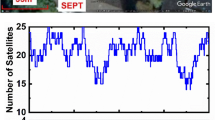Abstract
GNSS single-epoch real-time kinematic (RTK) positioning depends on correct ambiguity resolution. If the number of observed satellites in a single epoch is insufficient, which often happens with a standalone GNSS system, the ambiguity resolution is difficult to achieve. China’s BeiDou Navigation Satellite System has been providing continuous passive positioning, navigation and timing services since December 27, 2012, covering China and the surrounding area. This new system will increase the number of satellites in view and will have a significant effect on successful ambiguity resolution. Since the BeiDou system is similar to GPS, the procedure of data processing is easier than that for the Russian GLONASS system. We briefly introduce the time and the coordinate system of BeiDou and also the BeiDou satellite visibility in China, followed by the discussion on the combined GPS/BeiDou single-epoch algorithm. Experiments were conducted and are presented here, in which the GPS/BeiDou dual-frequency static data were collected in Wuhan with the baseline distance varying from 5 to 13 km, and processed in separate and combined modes. The results indicate that, compared to a standalone GPS or BeiDou system, the combined GNSS system can increase the successful ambiguity fixing rate for single epochs and can also improve the precision of short baselines determination.





Similar content being viewed by others
References
BeiDou ICD (2012) BeiDou navigation satellite system signal in space interface control document open service signal B1I (Version 1.0). Available at: http://en.beidou.gov.cn/beidoupolicy.html
China Satellite Navigation Office (2012) Report on the development of BeiDou navigation satellite system (Version 2.1). Available at: http://en.beidou.gov.cn/beidoupolicy.html
Euler H, Schaffrin B (1990) On a measure for the discernibility between different ambiguity solutions in the static-kinematic GPS-mode. Proceedings of IAG symposium no.107, kinematic systems in geodesy, surveying, and remote sensing. Springer, New York, pp 285–295
Frei E, Beutler G (1990) Rapid static positioning based on the fast ambiguity resolution approach FARA: theory and first results. Manuscripta Geodaetica 15:325–356
Han S, Rizos C (1996) Validation and rejection criteria for integer least-squares estimation. Surv Rev 33(260):375–382
Han C, Yang Y, Cai Z (2011) BeiDou navigation satellite system and its time scales. Metrologia 48(4):213–218
Hatch RR (1982) The synergism of GPS code and carrier measurements. In: proceedings of the third international symposium on satellite Doppler positioning. Physical Sciences Laboratory of New Mexico State University, Feb. 8–12, Vol. 2, pp 1213–1231
Hatch RR (1990) Instantaneous ambiguity resolution. Proceedings of IAG international symposium 107 kinematic systems in geodesy, surveying and remote sensing. Springer, New York, pp 299–308
Leick A (2003) GPS satellite surveying, 3rd edn. Wiley, New York
Melbourne W. (1985). The case for ranging in GPS based geodetic systems. In: proceedings of the first symposium on precise positioning with the global positioning system, Positioning with GPS-1985. U.S. Department of Commerce, Rockville, Md, pp 373–386
Remondi BW (1984) Using the global positioning system (GPS) phase observable for relative geodesy: modeling, processing, and results. Ph.D dissertation, Texas: The University of Texas
Remondi BW (1990) Pseudo-kinematic GPS results using the ambiguity function method. NOAA Technical Memorandum NOS NGS-52, U.S. Department of Commerce
Teunissen PJG (1993) Least-squares estimation of the integer GPS ambiguities. Invited lecture, section IV theory and methodology. IAG general meeting, Beijing, China
Teunissen PJG (1995) The least-squares ambiguity decorrelation adjustment: a method for fast GPS integer ambiguity estimation. J Geod 70(1):65–82
Teunissen PJG, Verhagen S (2009) The GNSS ambiguity ratio-test revisited: a better way of using it. Surv Rev 41(312):138–151
Verhagen S (2005) The GNSS integer ambiguities: estimation and validation. Ph.D dissertation, Delft: Delft University of Technology
Wang J, Stewart MP, Tsakiri M (1998) A discrimination test procedure for ambiguity resolution on-the-fly. J Geod 72(11):644–653
Wei Z (2008) China geodetic coordinate system 2000 and its comparison with WGS84. J Geod Geodyn 28(5):1–5 (In Chinese)
Wei M, Schwarz KP (1995) Fast ambiguity resolution using an integer nonlinear programming method. In: proceedings of the ION GPS-1995, Institute of Navigation, Palm Springs CA, pp 1101–1110
Wübbena G (1985) Software developments for geodetic positioning with GPS using TI-4100 code and carrier measurements. In: proceedings of the first symposium on precise positioning with the global positioning system, positioning with GPS-1985. U.S. Department of Commerce, Rockville, Md, pp 403–412
Zhang W, Cannon ME, Julien O, Alves P (2003) Investigation of combined GPS/GALILEO cascading ambiguity resolution schemes. In: proceedings of the ION GPS/GNSS-2003, Institute of Navigation, Portland, USA, pp 2599–2610
Acknowledgments
This work is partially sponsored by Natural Science Foundation of China (Grant No. 41004014 and No. 41304028), partially sponsored by National 863 Project of China (2012AA12A202), partially supported by “the Fundamental Research Funds for the Central Universities” (No. 2012214020208) and partially supported by “the Open Foundation of the State Key Laboratory of Geodesy and Earth’s Dynamics (Grant No. SKLGED2013-4-9-E).” The authors are very grateful to the anonymous reviewers for their constructive comments and suggestions.
Author information
Authors and Affiliations
Corresponding author
Rights and permissions
About this article
Cite this article
Deng, C., Tang, W., Liu, J. et al. Reliable single-epoch ambiguity resolution for short baselines using combined GPS/BeiDou system. GPS Solut 18, 375–386 (2014). https://doi.org/10.1007/s10291-013-0337-5
Received:
Accepted:
Published:
Issue Date:
DOI: https://doi.org/10.1007/s10291-013-0337-5




